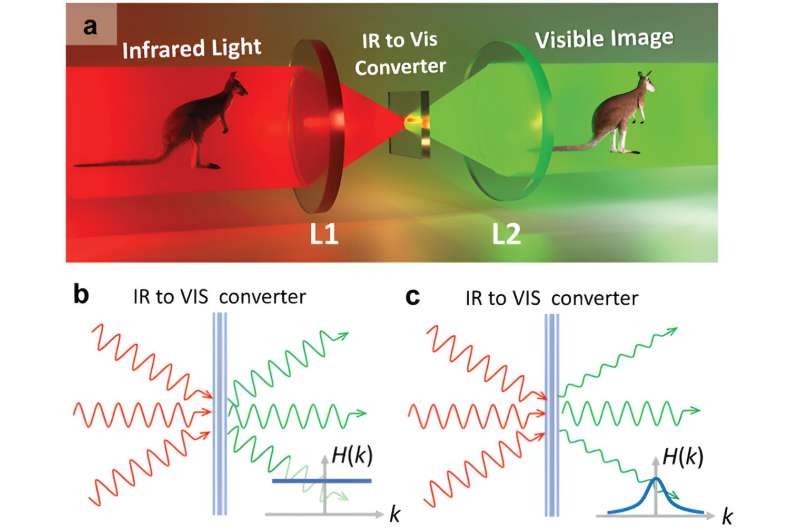
Upconversion from infrared (IR) to visible (VIS) for vision applications. a) Schematic of the nonlinear upconverter for infrared imaging, where infrared light illuminating an object and passing through a lens (L1) is coherently converted into visible light and captured by another lens (L2) to finally be observed on a conventional device. silicon-based camera. b) The ideal converter should convert all rays, incident at different angles, with the same efficiency, i.e. H(k) = constant. Credit: Advanced materials (2024). DOI: 10.1002/adma.202402777
Researchers at TMOS, the ARC Center of Excellence for Transformative Meta-Optical Systems, have made significant progress in their journey to deliver a new approach to night vision technology, creating a thinner infrared filter than a piece of cling film, and which could one day be placed on everyday glasses, allowing the user to view the spectrum of infrared and visible light simultaneously.
Night vision devices have primarily been used by the military, hunting enthusiasts willing to lug around versatile binoculars, or photographers happy to carry heavy lenses. This is due to the weight and bulk of the technology. The average person doesn’t go running at night with an extra kilo strapped to their forehead.
Miniaturization of night vision could therefore lead to widespread adoption. Creating night vision filters that weigh less than a gram and can be placed like a film over a traditional pair of glasses opens up new everyday applications.
Consumer night vision goggles that allow the user to see the visible and infrared spectrum at the same time could enable safer driving in the dark, safer nighttime walks, and fewer problems working in low light conditions. brightness which currently require bulky and often uncomfortable headlamps.
In research published in Advanced materialsTMOS researchers from the Australian National University demonstrate improved infrared vision nonlinear upscaling technology using a nonlocal lithium niobate metasurface.
Traditional night vision technology, particularly image intensifiers, requires infrared photons to pass through a lens, encounter a photocathode that turns those photons into electrons, and then pass through a microchannel plate to increase the number of electrons generated. These electrons pass through a phosphor screen to be converted back into photons, producing an intensified visible image that can be seen by the eye.
Unlike thermal imaging systems, which operate at much longer wavelengths and often require cryogenic cooling to avoid thermal noise, image intensifiers used in night vision devices generally do not require such cooling . However, a high-quality night vision system, like the one described above, is heavy and bulky. Additionally, these systems often block visible light.
Metasurface-based upscaling technology requires fewer elements, significantly reducing its footprint. Photons pass through a single resonant metasurface where they are mixed with a pump beam. The resonant metasurface enhances the energy of photons, pulling them into the visible light spectrum – no electron conversion is necessary. It also operates at room temperature, eliminating the need for bulky and heavy cooling systems.
Additionally, traditional infrared and visible imaging systems cannot produce identical images because they capture images of each spectrum side by side. Using upscaling technology, imaging systems can capture both the visible and non-visible in a single image.
The work is an improvement over the researchers’ original technology, which featured a gallium arsenide metasurface. Their new metasurface is made of lithium niobate, completely transparent in the visible region, which makes it much more effective. In addition, the photon beam is distributed over a wider area, limiting the angular loss of data.
Lead author Laura Valencia Molina says: “People have said that high conversion from infrared to visible is impossible due to the amount of information not collected due to the angular loss inherent in nonlocal metasurfaces. . We have overcome these limitations and experimentally demonstrate high-efficiency image upconversion.
Author Rocio Camacho Morales says, “This is the first demonstration of high-resolution upconversion imaging from 1,550 nm infrared to 550 nm visible light in a nonlocal metasurface. We choose these wavelengths because 1550 nm, an infrared light, is commonly used. for telecommunications, and 550 nm is visible light to which human eyes are very sensitive.
“Future research will include expanding the range of wavelengths to which the device is sensitive, with the aim of achieving broadband IR imaging, as well as exploring image processing, including edge detection.”
Chief investigator Dragomir Neshev says: “These results promise significant opportunities for the surveillance, autonomous navigation and biological imaging sectors, among others. The decreased weight and power requirements of night vision technology is an example of how meta-optics and TMOS work are crucial for Industry 4.0 and the future extreme miniaturization of technology. »
More information:
Laura Valencia Molina et al, Nonlinear upscaling-enhanced infrared vision in nonlocal metasurfaces, Advanced materials (2024). DOI: 10.1002/adma.202402777
Provided by the ARC Center of Excellence for Transformative Meta-Optical Systems (TMOS)
Quote: New all-optical approach could miniaturize night vision technology (June 3, 2024) retrieved June 4, 2024 from https://techxplore.com/news/2024-06-optical-approach-miniaturize-night-vision.html
This document is subject to copyright. Except for fair use for private study or research purposes, no part may be reproduced without written permission. The content is provided for information only.